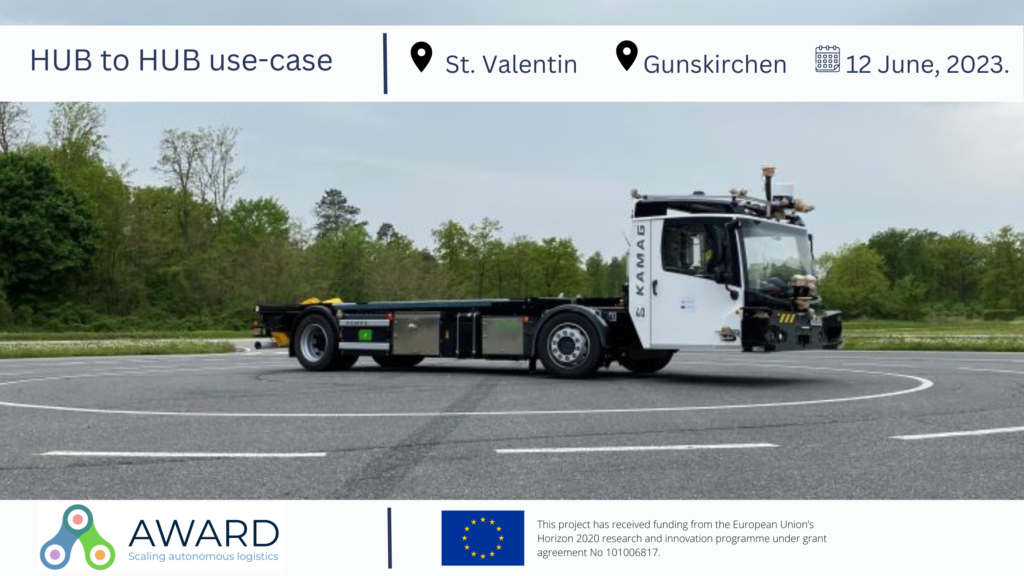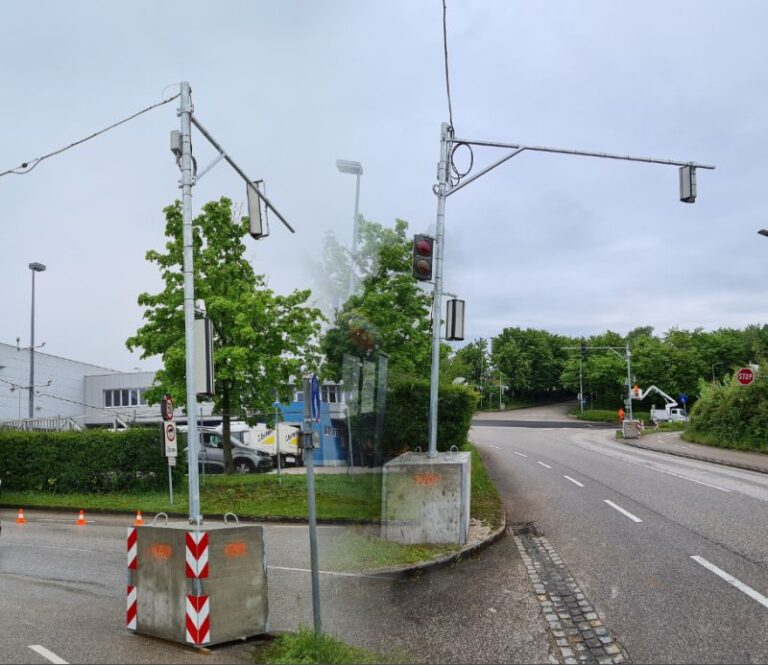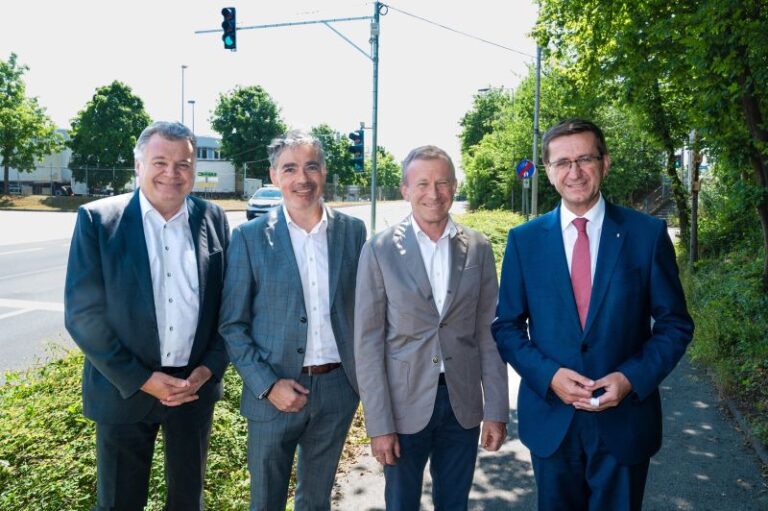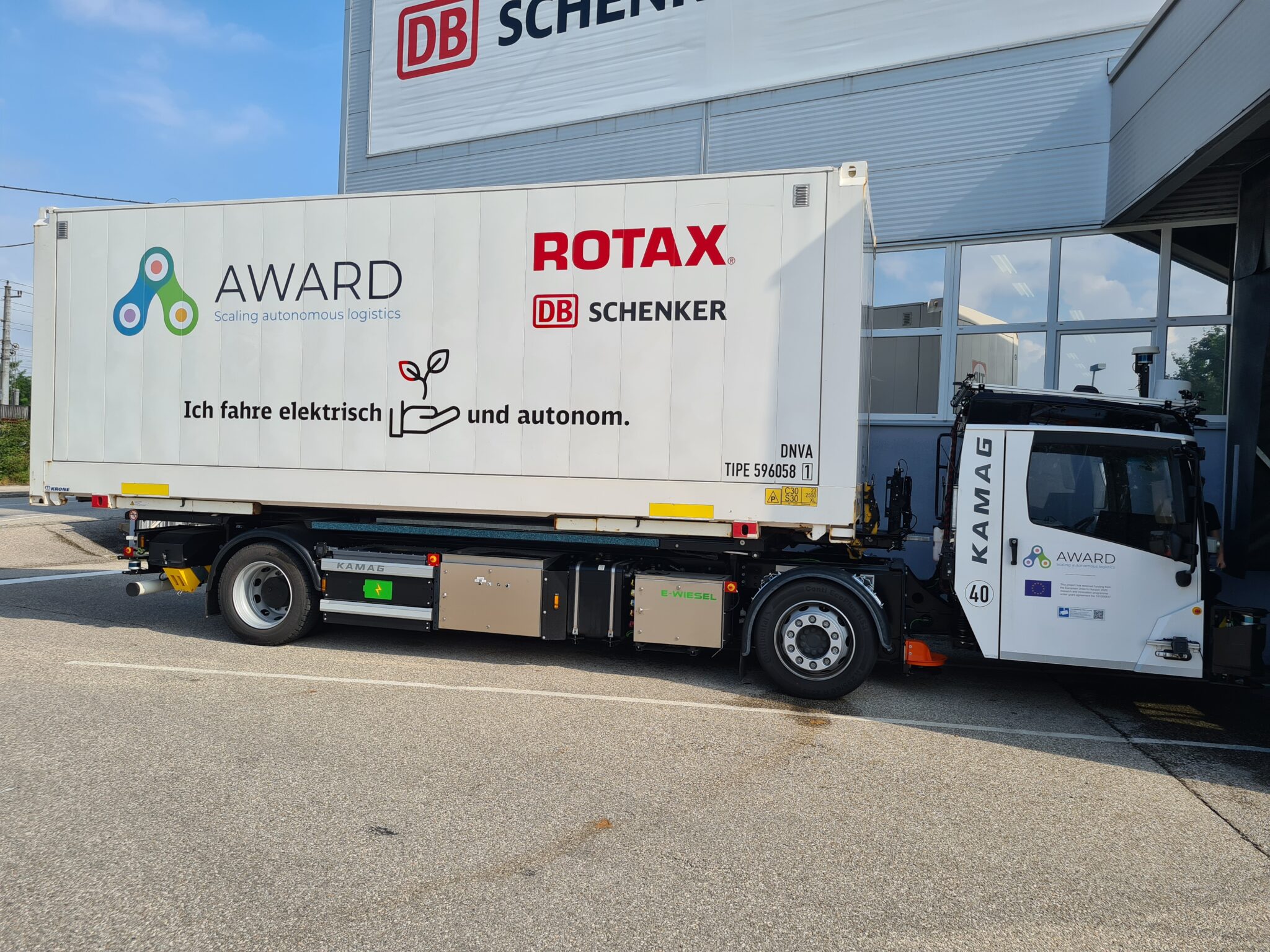AWARD´s Hub-to-Hub Use Case Testing
On June 12, 2023, the AWARD H2020 initiative achieved a significant milestone by unveiling an innovative autonomous logistics hub-to-hub testing concept in Gunskirchen, Austria. As part of the broader AWARD project, this endeavor involves the testing of a self-driving electric truck that not only operates traffic lights autonomously but also efficiently transports goods between two prominent companies (from ROTAX to DB Schenker plants in Austria). Part of the testing system is an intelligent traffic light solution that allows the vehicle to request traffic stops. The test track is a mixture of country roads with unregulated intersections, side streets, and partially unmarked roads. This testing phase is scheduled to run until September 2023 and is specifically centered around evaluating the capabilities of an automated swap-body truck, a creation of KAMAG, seamlessly integrated with cutting-edge EasyMile driverless technology.
*To find out more, download the press release from February 2023: ´The European project ¨AWARD¨ launches a new autonomous logistics use case in Gunskirchen, Austria´.
Demonstration Overview:
The deployment in Gunskirchen is structured into two phases: Phase I focuses on low traffic hours and traffic segregation via connected traffic lights, while Phase II optimizes safety margins and traffic light schedules to reduce congestion. Additionally, testing with teleoperation shifts to a controlled environment at the DigiTrans proving ground to gather data under various weather conditions, ensuring a thorough evaluation of the autonomous system’s capabilities and robustness.

* Be sure to stay connected with us to keep up with the latest developments. We’re committed to bringing you the most current information as we progress through this testing phase. As the testing concludes, we’ll be updating this blog with the final results and an array of captivating photos, giving you an immersive glimpse into the journey we’ve undertaken. Your curiosity is our motivation – so watch this space for the exciting revelations that await at the culmination of our testing endeavour!
Showcasing Autonomous Potential: The Hub-to-Hub Logistics Scenario
The main objective is to showcase the remarkable potential of this automated vehicle in a hub-to-hub logistics scenario. The project aims to support the future of goods transport, especially on short distances, as it is becoming increasingly difficult to find truck drivers. This demonstration is just one piece of the puzzle within the larger AWARD H2020 project, which aims to revolutionize the world of autonomous transportation. The hub-to-hub utilization scenario is among the four meticulously planned use cases within the expansive AWARD H2020 project. These encompass the Forklift, Airport, Port, and, notably, the hub-to-hub use case, each strategically designed to demonstrate the immense potential of autonomous technology in diverse operational settings.
*To read the latest updates on the use case scenarios read the June 2023: Newsletter #5 Revolutionizing logistics with autonomy!
* To read the latest updates on the Airport use case, download the press release from June 2023 – ´Revolutionary Autonomy in Airport Logistics Unveiled at AWARD H2020 Showcase´
Navigating Challenges: AWARD's Project Objectives
The overarching goal of these unique use cases is to establish the competence of autonomous vehicles across diverse weather conditions. Additionally, the project aims to tackle the challenges associated with deploying these vehicles in actual logistics operations. This is achieved through a series of strategic demonstrations tailored to meet the specific demands of the market, spanning from factory floors to bustling logistics hubs.
Collaborative Leadership: Consortium and Partners
At the helm of this use case is the consortium leader, Digitrans, who has enlisted the support of key players including Applied Autonomy, BRP-Rotax, DB Schenker, Kamag, Easymile, AustriaTech, Continental, and LCM. Together, they’re spearheading the Hub-to-hub autonomous logistics use case. This particular endeavour is all about showcasing the potential of autonomous heavy-duty vehicles in extended on-road driving scenarios. Our team of experts invested time in studying the business aspects related to Autonomous Logistics operations. In this pursuit, we greatly valued the inputs received from our stakeholders as we delved into the convergence of logistics, technology, and innovation. This exploration was especially focused on the context of the Hub-to-hub automation: Business Models for Autonomous Logistics – the AWARD Hub-to-hub use-case Survey.
Enhancing Capabilities: The Role of EasyMile's Technology
To elevate the capabilities of the KAMAG vehicle, it’s set to receive an upgrade in the form of EasyMile’s Autonomous Vehicle Technology. This upgrade promises to enhance its prowess in traffic simulation, communication, and obstacle detection.
Safety First: A Pioneering Drive
Ensuring utmost safety, the vehicle underwent rigorous testing in varying weather conditions and complex environments. Outfitted with sensors, it guarantees secure road navigation, while its current reduced speed aligns with safety precautions. A safety driver stands ready to intervene if necessary, exemplifying the unwavering commitment to safety. Collaborating with regulatory bodies, industry stakeholders, and partners, the AWARD team drives responsible and secure implementation of this groundbreaking technology, marking a significant stride towards the eventual deployment of autonomous vehicles on public roads.
Alexander Barth, CEO of Digitrans
Rebecca Ronke, Chief Operating Officer at Applied Autonomy
Continuously refining the truck, traffic light system, and route planning, efforts are dedicated to enhancing performance. The timeline for realizing autonomous goods transport remains uncertain, given the intricacies of legislation and insurance. The ultimate achievement envisions deploying a fully autonomous vehicle without a safety driver within controlled test confines. Even on public roads in Gunskirchen, a safety driver ensures vigilant caution. Embarking on an autonomous journey from ROTAX to DB Schenker plants in Austria, the KAMAG vehicle is poised for a momentous achievement. Prior to its road venture, the AWARD team meticulously tested its functionality, including obstacle perception and vehicle localization assessments. Rigorous tests aim for a seamless and dependable vehicle operation.
Austria's First Truly Intelligent Traffic Light Solution:
🚦 C-ITS Traffic Lights: Enhancing Interactive Traffic Support 🚦
These innovative C-ITS traffic lights enable seamless communication between vehicles and infrastructure. Prior to reaching a crossing, the vehicle shares its position and estimated arrival time with the traffic lights. This dynamic system is meticulously designed to bolster road safety. These cutting-edge traffic lights, found between the “Kreuzung Grünbachtalstraße – Kieswerkstraße” and “Kreuzung Blockstraße – Mendelweg” in Gunskirchen, mark their debut in Austria.
Their installation is a pivotal component of the Award Project – a Hub2Hub Transport initiative.


Automobil-Cluster, partner involved in the hub to hub use case
𝗚𝗿𝗲𝗲𝗻 𝗟𝗶𝗴𝗵𝘁 𝗳𝗿𝗼𝗺 𝘁𝗵𝗲 𝗖-𝗜𝗧𝗦 𝗧𝗿𝗮𝗳𝗳𝗶𝗰 𝗟𝗶𝗴𝗵𝘁𝘀 𝗳𝗼𝗿 𝘁𝗵𝗲 𝘀𝗲𝗹𝗳-𝗱𝗿𝗶𝘃𝗶𝗻𝗴 𝘁𝗿𝘂𝗰𝗸 𝗶𝗻 𝗚𝘂𝗻𝘀𝗸𝗶𝗿𝗰𝗵𝗲𝗻! 🚦 👏
About 600m is the track between DB Schenker and BRP-Rotax and this will now be driven by a self-driving truck from KAMAG. 🚚
To make this possible the C-ITS traffic lights are needed. It makes a bidirectional communication between vehicle and infrastructure possible – for the first time in Austria.
The vehicle is connected to the environment, for example, the weather station or the entrance and exit gates of the two company premises.
DIGITRANS, the hub-to-hub use case leader
Driving Progress: AWARD's Vision
As the AWARD autonomous driving system demonstrates its capabilities, the project aspires to play a pivotal role in fostering widespread adoption of this technology in the realm of logistics operations. The road ahead is paved with innovation and promise. AWARD’s autonomous logistics project stands as a beacon of technological advancement, steering us closer to a future where autonomous vehicles revolutionize how we move goods and reshape the landscape of transportation as we know it.
Highlight: two significant hurdles have emerged, demanding innovative solutions
1. Firstly, the autonomous transport system must demonstrate unwavering reliability even under adverse weather conditions, encompassing challenges such as rain or snow. These conditions put the sensors of the vehicles to the ultimate test, highlighting the need for robust technology.
2. Secondly, the chosen route necessitates traversing a public road. This not only underlines the complexity of navigating within the realms of daily traffic but also reinforces the importance of establishing an autonomous system that is not just efficient but also seamlessly integrates with existing transportation infrastructure.
Stay Tuned!
Be sure to stay connected with us to keep up with the latest developments. We’re committed to bringing you the most current information as we progress through this testing phase. As the testing concludes, we’ll update this blog with the final results and an array of captivating photos, giving you an immersive glimpse into our journey. Your curiosity is our motivation – so watch this space for the exciting revelations that await at the culmination of our testing endeavour!
Latest updates (January 2024)
Thank you for keeping a close eye on our updates! The tests of the use case on public roads are completed. The KAMAG Vehicle comes back to the proving ground for further tests (teleoperating / with, and without an operator). In the evolving landscape of autonomous logistics, the AWARD project’s Hub-to-Hub use case in Austria has been making significant strides. Operating on public roads, this initiative navigates a complex legal framework, integrating autonomous vehicles seamlessly into prevalent traffic flows. However, a critical challenge has been ensuring safety at crossings, especially as some road users tend to ignore red lights after 30 seconds in the evenings. The performance of autonomous operations, particularly in industrial sites and during reversing maneuvers, has been commendably robust, displaying a high level of technological maturity. However, there are avenues for improvement, especially in harsh weather conditions, mixed traffic environments, and overall system availability. Notably, while human operators average a speed of 16 km/h on these routes, autonomous systems operate at 6.4 km/h, underscoring a significant difference in operational efficiency. A crucial aspect of this use case is the implementation of teleoperation and Vehicle-to-Everything (V2X) communication.
Teleoperation has emerged as a critical enabler for realistic applications, providing remote assistance and intervention when necessary, in place of an onboard operator. The importance of V2X communication is also highlighted, enhancing the interaction and coordination with other road users in mixed traffic scenarios. Despite the satisfaction with the vehicle’s performance, the need for continuous improvement is recognized, particularly in challenging weather conditions and in managing interactions in mixed traffic situations. The current dependency on teleoperation indicates that as long as there is a requirement for a non-vehicular presence, the full benefits of autonomous operation cannot be completely realized. Human-Machine Interfaces (HMIs) play a significant role in this context, contributing to the acceptance and interaction between the system and its human counterparts.

Also! Don´t miss out on the latest news from the Final Phase of TII KAMAG’s AV Hub-to-Hub Operation in Austria, which was part of the AWARD Annual Meeting: Highlighting Remote-Controlled e-Truck Safety and Autonomous Technology Advancements.
Latest updates (March 2024)
We’re thrilled to announce the launch of our latest video showcasing the Hub-to-Hub use case!
The TII KAMAG autonomous vehicle was successfully utilized to transport goods between two designated hubs (logistics nodes): the BRP-Rotax factory site and the DB Schenker logistics site in Gunskirchen, Austria, as part of the AWARD H2020 project. The route encompassed the respective factories, secondary and main public roads, and bustling intersections. This use case offers valuable insights into the real-world application of autonomous vehicles for freight transport.
Watch the video to delve deeper into our experience using autonomous vehicles for freight transport between hubs!
Latest updates (June 2024): Final results and lessons learned
Results
- Total Testing: 38 days of testing on public roads.
- Teleoperation: 20 days of testing with teleoperation in a private area.
- Infrastructure Integration: Demonstrations with connected infrastructure (traffic lights, gates, weather stations).
- Public Acceptance: Moderate acceptance with initial traffic rule violations.
- Critical E-Stops: Critical emergency stops for loaded goods.
- Adverse Weather: Few days of bad weather, mainly safety operator interventions.
- Teleoperation: Successful demonstration of teleoperation.
Lessons Learned
- AV Performance: Improve driving behavior and operations in adverse weather conditions.
- Process Optimization: Optimize the overall work process, including loading, unloading, and charging.
